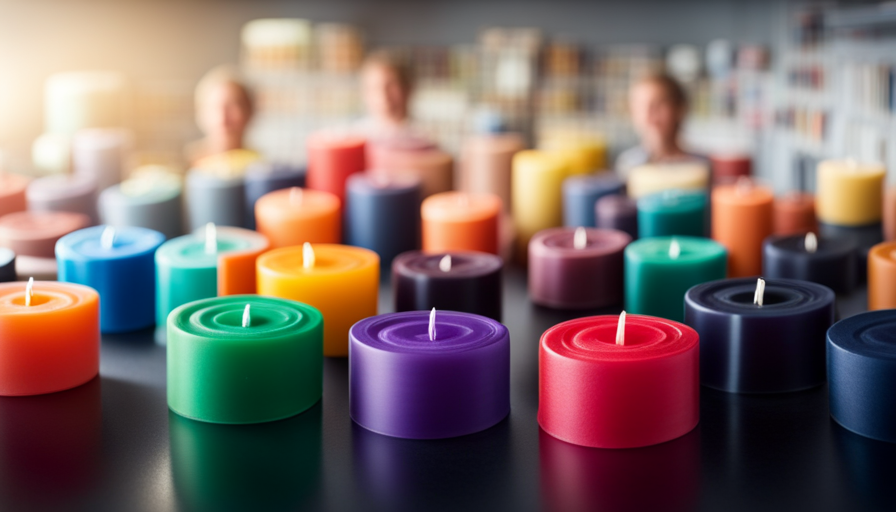Have you ever experienced the frustration of trying to extinguish a candle, only to have the wick smolder and produce smoke instead? I certainly have. That’s why I decided to invest in a candle snuffer, and it has truly made a difference in my candle-blowing experience.
Imagine this scenario: you’re hosting a dinner party and have lit several candles to create a cozy ambiance. As the night progresses, it’s time to call it a day and put out the candles. But instead of blowing them out and potentially sending hot wax flying, you simply reach for your candle snuffer.
With a quick and effortless motion, you cover the flame, completely extinguishing it without any mess or fuss.
In this article, I will guide you through the process of using a candle snuffer effectively. From understanding the purpose of a snuffer to choosing the right type, preparing the candle, and ensuring the flame is completely out, you’ll learn all the steps to enjoy the benefits of this handy tool.
So let’s get started and make candle extinguishing a breeze.
Key Takeaways
- Candle snuffers provide a graceful and safe way to extinguish candles, eliminating the risk of blowing hot wax or accidentally snuffing out the flame with fingers.
- There are three types of candle snuffers: bell snuffer, wick snuffer, and candlestick snuffer, each designed for different types of candles.
- Using a candle snuffer prevents wax splattering, smoke filling the room, and reduces the risk of accidental fires.
- Proper snuffing technique involves holding the snuffer steady and directly above the flame, covering the candle completely to smother the flame, and holding the snuffer in place for a few seconds to ensure the flame is completely extinguished.
Understand the Purpose of a Candle Snuffer
So, you’re ready to learn how to use a candle snuffer to add a touch of elegance to your candle-lit ambiance and keep wax from splattering everywhere. Candle snuffers have a rich history that dates back to the early 17th century, when they were first introduced as an essential tool for extinguishing candles. Back then, they were made of silver or brass and often had intricate designs.
Today, candle snuffers come in various materials, such as stainless steel or glass, and can be found in different shapes and sizes to suit your personal style.
Understanding the purpose of a candle snuffer is crucial. Not only does it provide a graceful way to extinguish a candle, but it also eliminates the risk of blowing hot wax onto nearby surfaces or accidentally snuffing out the flame with your fingers. By using a candle snuffer, you can maintain a clean and safe environment while enjoying the warm glow of a candle.
Although candle snuffers are the traditional choice, there are alternatives available. For instance, some people prefer using candle wick trimmers, which not only trim the wick but also extinguish the flame. Others may opt for candle extinguishing sprays or even simply blowing out the flame. However, if you want to add a touch of sophistication to your candle-lit moments, a candle snuffer is the way to go.
Now that you understand the purpose of a candle snuffer and have explored alternatives, let’s move on to the next section and find out how to choose the right type of candle snuffer.
Choose the Right Type of Candle Snuffer
Ironically, finding the perfect type of snuffer to extinguish those flickering flames can be quite the task. However, once you understand the different types of candle snuffers available, you can choose the one that best fits your needs.
Here are three types of candle snuffers and the benefits of using them:
-
Bell snuffer: This classic snuffer features a bell-shaped end that covers the flame, suffocating it and preventing smoke from escaping. It’s ideal for larger candles and can be used to extinguish multiple candles at once.
-
Wick snuffer: Designed specifically for container candles, this snuffer has a long handle and a small cone-shaped end that fits perfectly over the wick. It allows you to snuff out the flame without touching the wax, reducing the risk of burns or wax spills.
-
Candlestick snuffer: As the name suggests, this snuffer resembles a miniature candlestick. It’s great for taper candles and allows you to reach into narrow candle holders to extinguish the flame safely.
Using a candle snuffer not only prevents wax from splattering and smoke from filling the room but also reduces the risk of accidental fires.
Now that you know the different types of snuffers available, let’s move on to preparing the candle for extinguishing.
Prepare the Candle for Extinguishing
First, take a moment to carefully trim the wick of your flickering candle, ensuring a clean and even burn for the next time you light it. This simple step will help prevent any excess smoke or flickering flames when using your candle snuffer. Now that your candle is ready, let’s explore some candle snuffer alternatives and safety precautions to keep in mind.
When it comes to extinguishing candles, using a candle snuffer is the traditional and safest method. However, if you don’t have one on hand, there are alternatives you can use. A metal spoon or a metal lid from a jar can be used to gently press the wick against the wax, smothering the flame. Just be cautious when using these alternatives, as they may not be as effective or safe as a dedicated candle snuffer.
Now, let’s talk about safety precautions when using a candle snuffer. First and foremost, ensure that your snuffer is made of non-flammable material, such as metal or glass. This will prevent any accidental ignition. Additionally, always approach the candle with the snuffer from the side, avoiding any direct contact between the flame and the snuffer itself. This will minimize the risk of sparks or hot wax splattering.
With your candle prepared and safety precautions in mind, let’s move on to the next step: approaching the candle with the snuffer.
Approach the Candle with the Snuffer
Approaching the flickering flame with the snuffer is like gracefully taming a wild beast, ready to extinguish its fiery roar. When it comes to extinguishing a candle, the technique you use can make all the difference. To approach the candle with the snuffer, it’s important to take a steady and cautious approach.
Begin by positioning yourself directly above the candle, ensuring that your hand holding the snuffer is steady and secure. Slowly lower the snuffer towards the flame, making sure to keep a safe distance to avoid any accidental burns. As you get closer, you’ll notice the flame starting to dim. This is a sign that the snuffer is doing its job.
While using a snuffer is the traditional and most effective method, there are alternative extinguishing methods you can try. For instance, blowing out the candle with a quick and forceful breath is an option, but it can create a mess and potentially damage the wick. Another alternative is using a small damp cloth to smother the flame, but this can be risky if the cloth catches fire.
Now, with the candle safely extinguished, let’s move on to the next step: covering the flame with the snuffer.
Cover the Flame with the Snuffer
Gently lowering the snuffer over the flame creates a sense of control and serenity, as if taming a wild element with grace. It is important to cover the flame completely to extinguish it effectively. To master this cover technique, it is essential to understand the different types of candle snuffers and alternative methods available.
| Candle Snuffer Types | Alternative Methods |
|---|---|
| Bell-shaped snuffer | Metal spoon |
| Cone-shaped snuffer | Metal lid |
| Flat disk snuffer | Wet cloth |
The bell-shaped snuffer is a popular choice due to its elegant design and ease of use. Its curved shape allows for efficient coverage of the flame, preventing any hot wax or sparks from escaping. Alternatively, a metal spoon can be used by carefully placing it over the flame and suffocating it. For candles with lids, such as jar candles, a metal lid can be used as a makeshift snuffer. Lastly, a wet cloth can be used to smother the flame by covering it completely.
Once the flame is covered, it is important to hold the snuffer in place for a few seconds to ensure the flame is completely extinguished. This allows any remaining embers to be snuffed out, preventing any potential fire hazards.
Transitioning to the next section about "holding the snuffer in place for a few seconds," it is crucial to follow this step to ensure the candle is safely extinguished.
Hold the Snuffer in Place for a Few Seconds
Hold the snuffer in place for a few seconds, allowing the flame to surrender its fiery dance and be consumed by the tranquil embrace of darkness. This simple act is the essence of using a candle snuffer, a tool that offers numerous benefits.
By extinguishing the flame gently and efficiently, a snuffer helps prevent the release of smoke or sparks that can result from blowing out a candle. This makes it a safer option, especially in areas with flammable materials nearby. Moreover, using a snuffer prevents the wick from being disturbed or accidentally submerged in the melted wax, prolonging the life of the candle and ensuring a clean burn every time.
When holding the snuffer in place, it’s crucial to maintain a steady hand and keep the snuffer directly above the flame. This ensures that the snuffer completely covers the candle, smothering the flame and preventing any residual smoke or odor from escaping. The snuffer should be held in place for a few seconds to ensure the flame is fully extinguished.
With the flame now extinguished, it’s time to remove the snuffer carefully. This step is vital to prevent any accidental contact with the hot wax or wick. By gently lifting the snuffer away, you can ensure a safe and tidy experience.
Remove the Snuffer Carefully
Carefully removing the snuffer ensures a safe and seamless end to the candle-snuffing ritual. After holding the snuffer in place for a few seconds, it’s important to remove it with caution to prevent any accidents.
The first step is to gently lift the snuffer off the candle, making sure to keep it level and avoid any abrupt movements. This will prevent any hot wax or sparks from flying off and causing potential harm. Slowly and steadily, move the snuffer away from the candle, being mindful not to touch the flame or the hot wax.
It’s crucial to handle the snuffer with care, as it may still be hot from being in contact with the flame. Once the snuffer is safely removed, you can proceed to ensure the flame is completely extinguished.
By removing the snuffer carefully, you can effectively prevent any accidents and maintain a peaceful and safe environment.
Ensure the Flame is Completely Extinguished
To make sure the flame is completely out, simply blow on it until it disappears. This is a crucial step to ensure complete safety and prevent accidental fires.
Here are three reasons why this is important:
-
Prevents lingering embers: By blowing on the flame, you’re effectively extinguishing any remaining embers. These embers can easily reignite if left unattended, leading to potential fire hazards.
-
Eliminates smoke: Blowing on the flame helps disperse any residual smoke. This not only improves air quality but also reduces the risk of smoke inhalation, which can be harmful to your health.
-
Avoids accidental ignition: Even a small, seemingly extinguished flame can reignite if a draft or nearby object causes it to flicker. By blowing on the flame until it disappears, you can ensure that there are no remaining sparks that could potentially ignite flammable materials.
Now that the flame is completely out, it’s time to move on to the next step: cleaning and storing the candle snuffer properly. This is important to maintain its functionality and prolong its lifespan.
Clean and Store the Candle Snuffer Properly
Now that you’ve ensured the flame is completely extinguished, it’s time to give the candle snuffer a thorough cleaning and find a proper place to stow it away for future use, keeping it safe and sound.
Proper cleaning techniques are essential to maintain the functionality and appearance of your candle snuffer. Start by wiping the snuffer with a soft cloth or paper towel to remove any excess wax or soot. For stubborn wax residue, dip a cotton swab in rubbing alcohol and gently scrub the affected areas. Be sure to avoid using abrasive materials that could damage the snuffer’s surface.
Once the snuffer is clean, it’s important to store it properly to prevent any damage or loss. The best storage practice is to find a designated spot away from direct sunlight and excessive heat. This will help preserve the snuffer’s materials and prevent any discoloration or warping. Consider using a small pouch or container to keep the snuffer protected from dust and other potential contaminants.
With your candle snuffer now clean and safely stored, you’re ready to enjoy the benefits of using it.
Enjoy the Benefits of Using a Candle Snuffer
Indulge in the delightful advantages of employing a candle snuffer for your aromatic experience. Not only does it add a touch of elegance to your candle-lit moments, but it also offers several practical benefits. Here are three reasons why using a candle snuffer is beneficial:
-
Preserve the Fragrance: When you blow out a candle, the sudden gust of air can cause the fragrance to dissipate quickly. However, by using a snuffer, you can gently extinguish the flame without disturbing the scent, allowing it to linger in the air for a longer period.
-
Avoid Smoke and Soot: Blowing out a candle can result in smoke and soot, which can be unpleasant and leave residue on your walls or ceiling. With a snuffer, you can extinguish the flame without any smoke or soot, keeping your space clean and free from any unwanted marks.
-
Proper Snuffing Technique: Using a candle snuffer ensures that the flame is completely extinguished, reducing the risk of accidental fires. Simply place the snuffer over the flame, allowing the metal or ceramic cap to suffocate the fire gently. This technique isn’t only safe but also helps extend the lifespan of your candle.
By incorporating a candle snuffer into your routine, you can enjoy a more pleasant and hassle-free candle experience. So, next time you light a candle, remember to snuff it out for a truly enjoyable ambiance.
Frequently Asked Questions
Is it necessary to use a candle snuffer or can I just blow out the candle?
Blowing out a candle may be a common practice, but using a candle snuffer has its benefits. As the saying goes, ‘Better safe than sorry.’ Candle snuffer alternatives like blowing can cause wax to splatter or create a fire hazard.
A candle snuffer, on the other hand, extinguishes the flame gently and without any mess. It also helps to prevent accidental burns and keeps your surroundings clean. So, it’s definitely worth considering using a candle snuffer for a safer and cleaner experience.
Can I use a candle snuffer on any type of candle?
Yes, you can use a candle snuffer on any type of candle. Using a candle snuffer has several benefits. It helps to extinguish the candle without blowing wax or smoke around, which can be messy and unpleasant.
Additionally, it allows for a controlled and gentle extinguishing of the flame, reducing the risk of accidents or damage. Using a candle snuffer also helps to preserve the wick, allowing for a longer burn time and a more even melt pool.
Are there any safety precautions I should take when using a candle snuffer?
When using a candle snuffer, it’s important to follow certain safety precautions. First, ensure that the candle is completely extinguished before using the snuffer. This can be done by gently pressing the snuffer onto the flame until it goes out. Avoid blowing on the flame, as this can cause hot wax to splatter.
Additionally, always use a snuffer with a long handle to prevent burns. These best practices will help you safely and effectively use a candle snuffer.
How do I clean a candle snuffer properly?
Cleaning a candle snuffer is an essential part of its maintenance. To ensure its longevity and effectiveness, follow these cleaning methods and maintenance tips.
First, gently wipe off any excess soot or wax residue using a soft cloth.
Then, soak the snuffer in warm soapy water for a few minutes. Use a small brush or toothbrush to scrub away any stubborn stains.
Rinse thoroughly and dry completely before storing.
Regular cleaning will keep your candle snuffer looking and working like new.
Can I leave a candle snuffer on the candle after extinguishing the flame?
Yes, it’s safe to leave a candle snuffer on the candle after extinguishing the flame. The snuffer acts as a lid, preventing dust and debris from falling into the wax and keeping the candle clean and ready for your next use.
Additionally, leaving the snuffer on the candle provides convenient storage, as it keeps the snuffer within reach and ensures that it doesn’t get misplaced.
Conclusion
In conclusion, using a candle snuffer is a simple yet effective way to extinguish a candle flame safely and efficiently. By following the steps outlined in this article, you can ensure that your candle is properly snuffed out without any risk of accidents or damage.
Did you know that using a candle snuffer can help your candles last longer? According to a study, snuffing out the flame instead of blowing it out can prevent wax from splattering and reduce smoke, ultimately extending the life of your candles. So, why not give it a try and enjoy the benefits of using a candle snuffer?
















